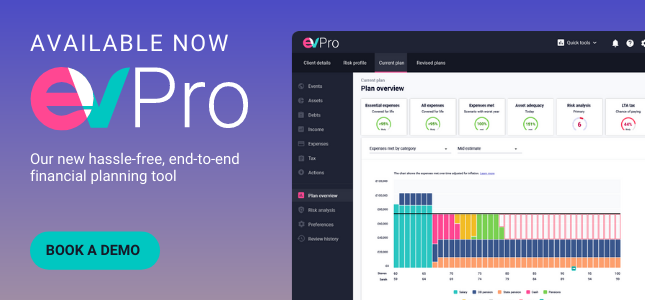Stress testing: How to help eliminate your clients’ cash flow planning stress

Everyone with investments has some degree of stress about their future wealth. Let’s look at how – thanks to recently launched EVPro – advisers have the tools they need to put their clients’ minds at rest, presenting realistic forecasts based on advanced stress-test functionality that takes account of both past events and future possibilities.
Wouldn’t it be wonderful – and make life a lot less stressful – if we could predict the future based only on what’s happened in the past?
In reality, using the past to predict the future is inherently risky – and stress-inducing for clients caught out when things go wrong. As high profile sagas concerning former star fund managers emphatically underline, former glory offers no guarantee of future success.
Should the past play a part in modelling the future?
There is indeed a contrarian view in other disciplines – think anthropology and psychology – where it’s asserted it is naive to dismiss the past. But, for example, a common theory in psychological circles suggests that past behaviour is the most reliable predictor of future behaviour.
This piece aims not to judge which belief system wins the day. Economics and finance are distinctly different from psychology and anthropology. But rather than suggesting one concept is right and the other wrong, both can and should be relevant to the financial planning process. This is particularly true when it comes to cash flow modelling.
Some client objectives require advisers to look many years into the future for their clients, making assumptions about changing variables such as investment volatility. The accuracy of these forecasts is crucial in helping clients understand what action needs to be taken today to reach their financial goals. Hence, forecasting models have had to become more sophisticated.
Past history should inform stress testing the future
We only need to cast our minds back a couple of decades to recall when go-to investment illustrations used nominal fixed growth rates to indicate to clients what their investments might be worth five, 10 or 20 years down the line. This was unsatisfactory, as history tells us that investment growth is far from linear in that manner… the inherent nature of asset-backed investments means volatility will always be lurking, if not currently present. Therefore, if we want to ensure clients are serviced fairly, any forecast made on their behalf should include a degree of randomness to closely mirror the real behaviour of national economies and financial markets.
Thankfully, many of the current suites of forecasting models are significantly more sophisticated than the outdated linear example mentioned above. The most remarkable are stochastic models, which employ a degree of real-life unpredictability and randomness to predict potential outcomes. The upshot here is that while it’s impossible to know how the future will unfold, we can replicate previous economic events to delve into how a client’s portfolio would hold up should specific scenarios occur. And stress testing the investment choices clients make given these various scenarios can go a long way in justifying their options – or signposting alternatives.
Read our accompanying blog; Stochastic vs Deterministic Models: Understand the Pros and Cons, to find out more.
Tooling up for "what-if" stress-testing
For financial advisers, asking clients good questions such as ‘how would your family cope if you were to die?’ and ‘if you reached your intended retirement date without sufficient funds, what would you do?’ are par. The aim is to shed light on a client’s capacity to bear the financial loss. The great thing about advanced cash flow models is that these ‘what if’ scenarios can be baked into the assumptions, with their potential impact stress-tested on the client’s portfolio. So, for instance, the model could replicate a historic stock market crash, offering the valuable client insight into how their portfolio would fare should history repeat itself. Not all cash flow models, however, are created equal. More simplistic versions, known as deterministic models, overlook historical behaviour, lacking the required accuracy as the future unfolds.
Acknowledging these differences in approach in the market helped drive the development of our EVPro suite of tools, especially the ‘Solver’ function. When assisting clients in planning for their retirement, it’s crucial advisers have access to the necessary tools. For example, our stochastic-based Solver software stress-tests a number of ‘what if’ scenarios and analyses the likelihood of a client reaching their retirement targets, expressed as a percentage. Advisers can use this clear information to work with the client to change existing or future provisions, averting the shock of becoming aware of any shortfalls when it’s too late.
Accordingly, we have built into EVPro the functionality to stress-test vital factors, including:
- Probability of meeting expenditure – covering every year from the present to the end of the plan
- Expenses met – indicating the worst-case scenario, i.e. by how much the expenditure target is met if there is a shortfall
- Asset adequacy – the proportion by which all the assets could be adjusted, and the expenditure still met with the target probability
As part of this, our software takes account of myriad risks – and EVPro is the clear winner in conducting an array of core market stress-tests compared with conventional long-term cash flow (LTCF) and Monte Carlo models:
| Risk to consider | Traditional LTCF with stress testing | Monte Carlo cash flow | EVPro Solver |
| Market values changing | Yes (1-10 scenarios) | Yes - either correlation matrix or non-independent historic only | Yes (1,000 independent scenarios across 27 different asset classes) |
| Diversification | No | Yes - correlation matrix provided | Yes- dynamic correlation |
| Sequencing risk | No | Yes | Yes |
| Pound cost ravaging | No | Yes | Yes |
| Inflation risk | No - fixed assumptions | No - inflation tends to be fixed amount and not linked to | Yes - inflation is consistent with the asset returns in each year |
| Diversification fails due to large market downturns | No | No | Yes - dynamic correlation adjusts for major market shocks |
| Future annuity pricing | No | No - not possible due to inability to take into account changes in yield curve | Yes - Asset model based on the yield curve |
This and more is waiting to be discovered and utilised by advisers in their pursuit of providing the high quality, reassuring service expected by clients confronted by an uncertain world.
It’s clear that although the past cannot be used to predict a certain future, taking account of what has happened previously can play a pivotal role in helping the adviser and the client work towards the latter’s financial goals with more confidence. And with less stress about what may come.
So what next?
Stress testing effectively gauges how financial plans will fare in various market scenarios and how these scenarios will affect a client’s overall financial goals. Ensuring financial advice is consistent and suitable amidst these conditions should be a priority for all advisers, so drawing on the benefits of modern financial stress-testing software, like EVPro’s, can enable better financial planning and optimise your time spent serving clients.
